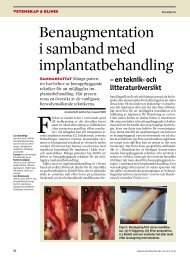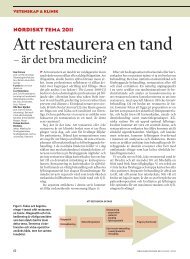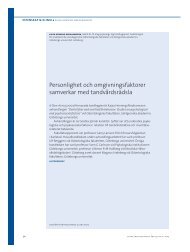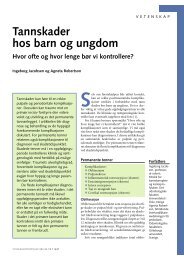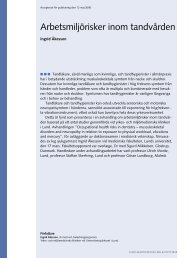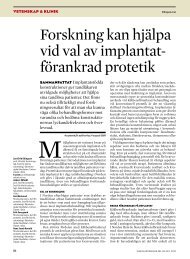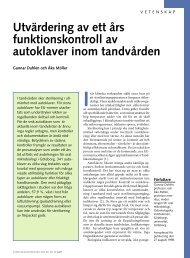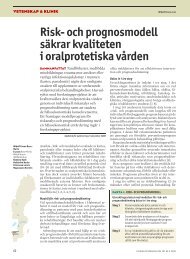Stamceller - nya möjligheter för odontologin? - Tandläkartidningen
Stamceller - nya möjligheter för odontologin? - Tandläkartidningen
Stamceller - nya möjligheter för odontologin? - Tandläkartidningen
You also want an ePaper? Increase the reach of your titles
YUMPU automatically turns print PDFs into web optimized ePapers that Google loves.
<strong>Stamceller</strong> inom <strong>odontologin</strong><br />
sökningar har det noterats att pulpala celler har en<br />
mycket växtstimulerande inverkan på nervvävnad<br />
[5, 13–15]. Det är kanske inte omöjligt att dpscs kan<br />
fömås att anta en neuronal inriktning och att de kan<br />
differentiera till nervliknande eller glialiknande celler.<br />
dpscs kan kanske i så fall till och med användas<br />
<strong>för</strong> att reparera skador i nervsystemet. Fördelen<br />
med dpscs är ju att de är relativt lättåtkomliga och<br />
kan utvinnas ur exempelvis en extraherad visdomstand.<br />
Denna tillgänglighet skulle kunna göra pulpala<br />
stamceller attraktiva <strong>för</strong> att ersätta nervvävnad.<br />
Kanske kan också andra vävnader bildas med hjälp<br />
av tekniker som påverkar dpscs att välja olika alternativa<br />
utvecklingsbanor. Det är ett fascinerande<br />
framtidsscenario.<br />
English summary<br />
Stem cells<br />
– new therapeutic possibilities in odontology?<br />
Kaj Fried, Mikael Wendel<br />
<strong>Tandläkartidningen</strong> 2002; 95 (7): 44–9<br />
Embryonic stem cells have an extraordinary ability<br />
to form a large number of cell types. Stem cells<br />
with the potential to differentiate are also present<br />
in many adult tissues, and such cells have been<br />
used clinically for regeneration in the haematopoietic<br />
system and of skin and cornea. Recent reports<br />
have indicated that adult stem cells may have a<br />
much greater potential for differentiation than<br />
previously thought. The access to both embryonic<br />
and adult stem cells with high levels of plasticity<br />
has evoked hopes for new cell-based therapeutic<br />
regimens for debilitating human conditions like<br />
Alzheimer’s disease, Parkinsons’s disease, stroke<br />
and diabetes. New findings have shown that different<br />
stem cell populations are also present in bone,<br />
cementum and in the dental pulp. Such cells are<br />
able to regenerate bone and its marrow, cementum,<br />
dentin and perhaps also periodontal ligament.<br />
Potentially, stem cells of either embryonic<br />
or adult origin could drastically improve the possibilities<br />
of repairing orofacial bone or teeth, and may<br />
even be used to regenerate new teeth. This field is<br />
still in its infancy and a series of scientific, technical<br />
and ethical problems remain to be solved. Despite<br />
this, some important and exciting possibilities<br />
seem to await down the road.<br />
Referenser<br />
1. Alberts B, Johnson A, Lewis J, Raff M, Roberts K<br />
and Walter P. Molecular biology of the cell.<br />
Garland Science, Taylor & Francis, New York, NY<br />
(4 th ed) 2002.<br />
2. Bianco P, Robey PG. Stem cells in tissue engineering.<br />
Nature 2001; 414: 118–21.<br />
3. Chai Y, Jiang X, Ito Y, Bringas P Jr, Han J, Rowitch DH,<br />
Soriano P, McMahon AP, Sucov HM. Fate of the<br />
mammalian cranial neural crest during tooth and<br />
mandibular morphogenesis. Development 2000;<br />
127: 1671–9.<br />
4. Cobourne MT, Sharpe PT. Tooth and jaw: molecular<br />
mechanisms of patterning in the first branchial arch.<br />
Arch Oral Biol 2003; 1283: 1–14.<br />
5. Fried K, Nosrat C, Lillesaar C, Hildebrand C.<br />
Molecular signaling and pulpal nerve development.<br />
Crit Rev Oral Biol Med 2000; 11: 318–32.<br />
6. Grzesik WJ, Kuzentsov SA, Uzawa K, Mankani M,<br />
Robey PG, Yamauchi M. Normal human cementumderived<br />
cells: isolation, clonal expansion, and in vitro<br />
and in vivo characterization. J Bone Miner Res<br />
1998: 13: 1547–54.<br />
7. Grzesik WJ, Narayanan AS. Cementum and periodontal<br />
wound healing and regeneration. Crit Rev<br />
Oral Biol Med 2002; 13: 474–84.<br />
8. Gronthos S, Mankani M, Brahim J, Robey PG, Shi S.<br />
Postnatal human dental pulp stem cells (DPSCs)<br />
in vitro and in vivo. Proc Natl Acad Sci USA<br />
2000; 97: 13625–30.<br />
9. Gronthos S, Brahim J, Li W, Fisher LW, Cherman N,<br />
Boyde A, DenBesten P, Robey PG, Shi S. Stem cell<br />
properties of human dental pulp stem cells.<br />
J Dent Res 2002; 81: 531–5.<br />
10. Krebsbach PH, Kuznetsov SA, Bianco P, Robey PG.<br />
Bone marrow stromal cells: characterization and<br />
clinical application. Crit Rev Oral Biol Med<br />
1999; 10: 165–81.<br />
11. Krebsbach PH, Robey PG. Dental and skeletal stem<br />
cells: potential cellular therapeutics for craniofacial<br />
regeneration. J Dent Educ 2002; 66: 766–73.<br />
12. Lemischka IR, Raulet DH, Mulligan RC. Developmental<br />
potential and dynamic behavior of hematopoetic<br />
stem cells. Cell 1986; 45: 917–27.<br />
13. Lillesaar C, Eriksson C, Fried K. Rat tooth pulp cells<br />
elicit neurite growth from trigeminal neurones and<br />
express mRNAs for neurotrophic factors in vitro.<br />
Neurosci Lett 2001; 308: 161–4.<br />
14. Lillesaar C, Eriksson C, Johansson CS, Fried K,<br />
Hildebrand C. Tooth pulp tissue promotes neurite<br />
outgrowth from rat trigeminal ganglia in vitro.<br />
J Neurocytol 1999; 28: 663–70.<br />
15. Nosrat IV, Widenfalk J, Olson L, Nosrat CA. Dental<br />
pulp cells produce neurotrophic factors, interact with<br />
trigeminal neurons in vitro, and rescue motoneurons<br />
after spinal cord injury. Dev Biol 2001; 238: 120–32.<br />
16. Ringe J, Kaps C, Burmester GR, Sittinger M. Stem cells<br />
for regenerative medicine: advances in the engineering<br />
of tissues and organs. Naturwissenschaften<br />
2002; 89: 338–51.<br />
17. Thesleff I, Mikkola M. The role of growth factors in<br />
tooth development. In. Rev Cytol 2002; 217: 93–135.<br />
18. Toma JG, Akhavan M, Fernandes KJ, Barnabe-<br />
Heider F, Sadikot A, Kaplan DR, Miller FD. Isolation<br />
of multipotent adult stem cells from the dermis of<br />
mammalian skin. Nat Cell Biol 2001; 3: 778–84.<br />
19. Tucker AS, Sharpe PT. Molecular genetics of tooth<br />
morphogenesis and patterning: the right shape in<br />
the right place. J Dent Res 1999; 78: 826–34.<br />
20. Verfaillie CM. Adult stem cells: assessing the case<br />
for pluripotency. Trends Cell Biol 2002; 12: 502–8.<br />
21. Weissman IL.Translating stem and progenitor cell<br />
biology to the clinic: barriers and opportunities.<br />
Science 2000; 287: 1442–6.<br />
22. Young CS, Terada S, Vacanti JP, Honda M, Bartlett JD,<br />
Yelick PC. Tissue engineering of complex tooth<br />
structures on biodegradable polymer scaffolds.<br />
J Dent Res 2002; 81: 695–700.<br />
Adress:<br />
Kaj Fried och<br />
Mikael Wendel,<br />
Centrum <strong>för</strong> Oral<br />
Biologi, Novum<br />
Karolinska Institutet,<br />
Box 4064,<br />
141 04 Huddinge<br />
E-post: Kaj.Fried<br />
@cob.ki.se<br />
tandläkartidningen årg 95 nr 7 2003<br />
49



